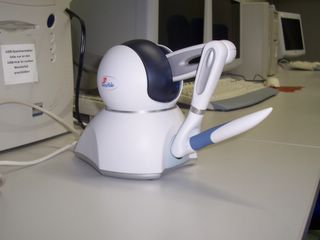Timeline Update -- Phase 1
This phase was to determine whether the project was possible. It explored different graphics components based on openGL. It also focused on current trends in research related to haptics and visual representation. The scope and major hurdles for the project were determined. The project will proceed.
Issues Encountered:
Issues encountered have either been resolved or a work around exists. One issue was the discovery of the limit of the haptic device. The force feedback is only in 3 dimensions. A fully functional system must incorporate at least 5 degrees of freedom feedback. To overcome this issue, all drilling be done perpendicular to the drilling plane.
Another issue was moving the tool center point (TCP) of the haptic device. As stated in other posts, the TCP must be at the drilling endpoint. Using the HDAPI the TCP can be moved and have forces generated based on the new position. The remaining issue is that the HLAPI cannot be used without modifying its source code. Using the HDAPI requires custom collision detection and force rendering.
Accomplishments:
An openGL graphic environment was created. An ASCII STL file can be loaded. Force feedback can be generated using the STL file. A voxel shell can be loaded into the environment and the haptic device can simulate removing pieces. Camera angles can be moved.
Known Issues:
Haptic to viewing transformation/mapping
Must implement custom force/collision detection -- HLAPI cannot be used
How to attach drilling device to haptic device.
Drawing 100,000 Voxels is upper limit of machine
Skills and Knowledge Acquired:
programming with openGL
What voxels are and their costs and benefits
how to incorporate API's into existing code
what callbacks are and how they interact with a scheduler
Interact with developers using Sensable Developers Forum



